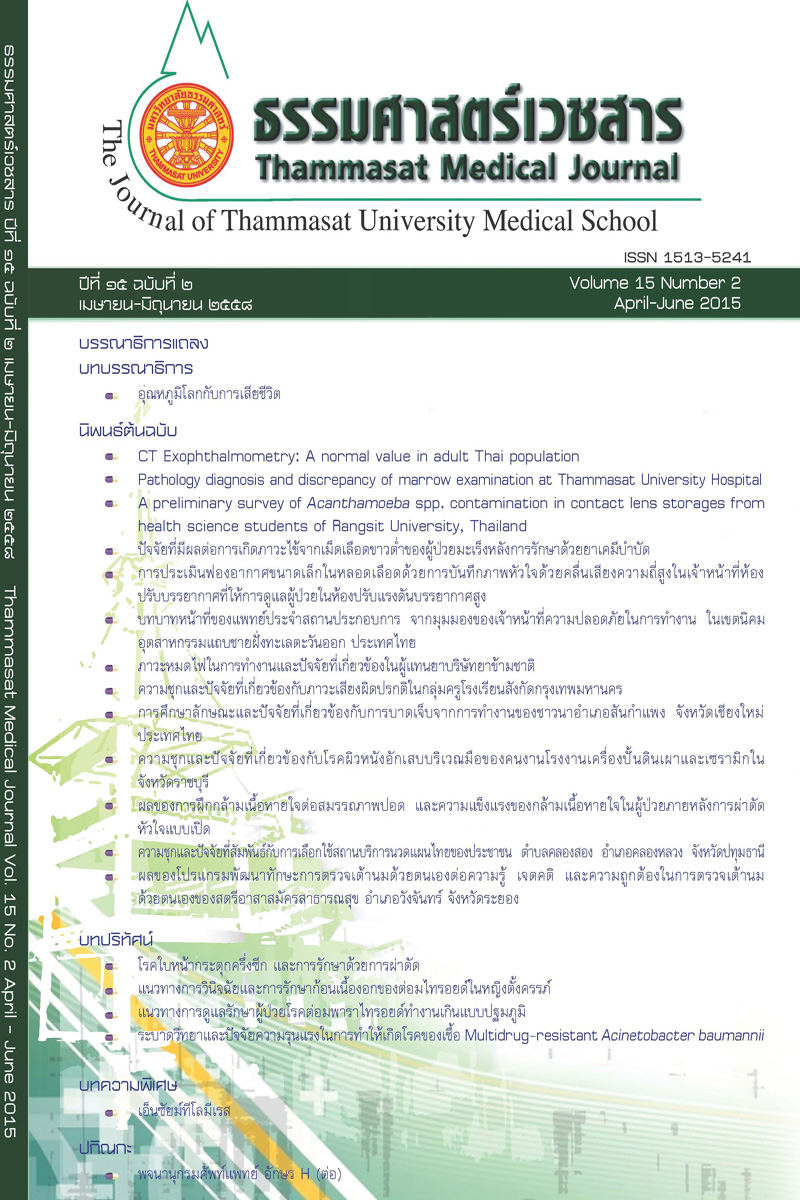Effect of respiratory muscle training on lung function and respiratory muscle strength in patients undergoing open heart surgery
Keywords:
Inspiratory muscle training, Respiratory muscle strength, Open heart surgery, Physical therapy, การฝึกกล้ามเนื้อหายใจเข้า, ความแข็งแรงของกล้ามเนื้อหายใจ, การผ่าตัดหัวใจแบบเปิด, กายภาพบำบัดAbstract
Introduction: Physical therapy is one treatment for decreased complications after open heart surgery. The effect of respiratory muscle training combined with physical therapy treatment in patient undergoing open heart surgery has conflict in many training factors. Therefore, this study aimed to investigate the effect of inspiratory muscle training (IMT) on spirometry and respiratory muscle strength in patient undergoing open heart surgery.
Method: Fourteen subjects who undergoing open heart surgery were assigned randomly into two groups: 8 patients in the training group and 6 patients in the control group. All subjects received a physical therapy program. In addition, subjects in the training group received inspiratory muscle training (IMT) by Inspiratory threshold-loading device, spirometry (FVC, FEV1 and FEV1/FVC), inspiratory and expiratory muscle strength (maximal inspiratory pressure; MIP & maximal expiratory pressure; MEP) were assessed preoperatively, and the eighth day after surgery in both groups.
Result: For the training group, MIP was not significantly different after operation (Pre: 76.50 ± 10.24 cmH2O, Post: 61.75 ± 7.87 cmH2O, p > 0.05) when compared with pre-operation. However, in the control group, MIP was significantly reduced after operation (Pre: 67.50 ± 2.92 cmH2O, Post: 53.00 ± 5.23 cmH2O, p ≤ 0.05) compared with pre-operation. Furthermore, spirometry was significantly decreased after operations in both groups (p ≤ 0.05).
Discussion and Conclusion: Inspiratory muscle training combined with physical therapy program in patient undergoing open heart surgery can maintain inspiratory muscle strength when compared with pre-operation. Therefore, IMT may be an additional treatment in patients undergoing open heart surgery, to increase respiratory muscle strength.
Key words: Inspiratory muscle training, Respiratory muscle strength, Open heart surgery, Physical therapy
ผลของการฝึกกล้ามเนื้อหายใจต่อสมรรถภาพปอด และความแข็งแรงของกล้ามเนื้อหายใจในผู้ป่วยภายหลังการผ่าตัดหัวใจแบบเปิด
ศศิภา บูรณพันธฤกษ์, ปรียาภรณ์ สองศร
ภาควิชากายภาพบำบัด คณะสหเวชศาสตร์ มหาวิทยาลัยธรรมศาสตร์
บทคัดย่อ
บทนำ: กายภาพบำบัดเป็นการรักษาหนึ่งที่ลดภาวะแทรกซ้อนภายหลังการผ่าตัดหัวใจแบบเปิด แต่ผลการฝึกกล้ามเนื้อหายใจร่วมกับการรักษาทางกายภาพบำบัดในผู้ป่วยพบว่ายังมีความขัดแย้งกัน การศึกษานี้มีวัตถุประสงค์เพื่อศึกษาผลของการฝึกกล้ามเนื้อหายใจเข้าต่อสมรรถภาพปอด และความแข็งแรงของกล้ามเนื้อหายใจในผู้ป่วยภายหลังการผ่าตัดหัวใจแบบเปิด
วิธีการศึกษา: ผู้เข้าร่วมงานวิจัยที่เข้ารับการผ่าตัดหัวใจแบบเปิด จำนวน ๑๔ คน แบ่งเป็น ๒ กลุ่ม คือ กลุ่มทดลอง ๘ คน และกลุ่มควบคุม ๖ คน ทั้งสองกลุ่มได้รับการรักษาทางกายภาพบำบัดภายหลังการผ่าตัด โดยกลุ่มทดลองได้รับการฝึกกล้ามเนื้อหายใจเข้า ด้วย Inspiratory threshold-loading device ร่วมด้วยทดสอบสมรรถภาพปอด (forced vital capacity; FVC, forced expiratory volume in one second; FEV1 และ FEV1/FVC) ความแข็งแรงของกล้ามเนื้อหายใจเข้า (maximal inspiratory pressure; MIP) และออก (maximal expiratory pressure; MEP) ก่อนการผ่าตัดและวันที่ ๘ ภายหลังการผ่าตัด
ผลการศึกษา: กลุ่มทดลอง มีค่าความแข็งแรงของกล้ามเนื้อหายใจเข้า (MIP) ภายหลังการฝึก ไม่แตกต่างเมื่อเปรียบเทียบก่อนผ่าตัด (ก่อน: ๗๖.๕๐ ± ๑๐.๒๔ cmH2O, หลัง: ๖๑.๗๕ ± ๗.๘๗ cmH2O; p > ๐.๐๕) ขณะที่กลุ่มควบคุมความแข็งแรงของกล้ามเนื้อหายใจเข้าลดลงอย่างมีนัยสำคัญทางสถิติ เปรียบเทียบก่อนผ่าตัด (ก่อน: ๖๗.๕๐ ± ๒.๙๒ cmH2O, หลัง: ๕๓.๐๐ ± ๕.๒๓ cmH2O; p ≤ ๐.๐๕) และค่าสมรรถภาพปอดของทั้งสองกลุ่มลดลงอย่างมีนัยสำคัญทางสถิติ เมื่อเทียบกับก่อนผ่าตัด (p ≤ ๐.๐๕)
วิจารณ์ และสรุปผลการศึกษา: การฝึกกล้ามเนื้อหายใจเข้า ร่วมกับการรักษากายภาพบำบัดสามารถคงความแข็งแรงของกล้ามเนื้อหายใจเข้า เมื่อเทียบกับก่อนการผ่าตัดได้ ดังนั้นการฝึกกล้ามเนื้อหายใจเข้าจึงอาจเป็นวิธีการรักษาเพิ่มเติมร่วมกับการรักษาทางกายภาพบำบัด เพื่อเพิ่มประสิทธิภาพของกล้ามเนื้อหายใจได้
คำสำคัญ: การฝึกกล้ามเนื้อหายใจเข้า, ความแข็งแรงของกล้ามเนื้อหายใจ, การผ่าตัดหัวใจแบบเปิด, กายภาพบำบัด


